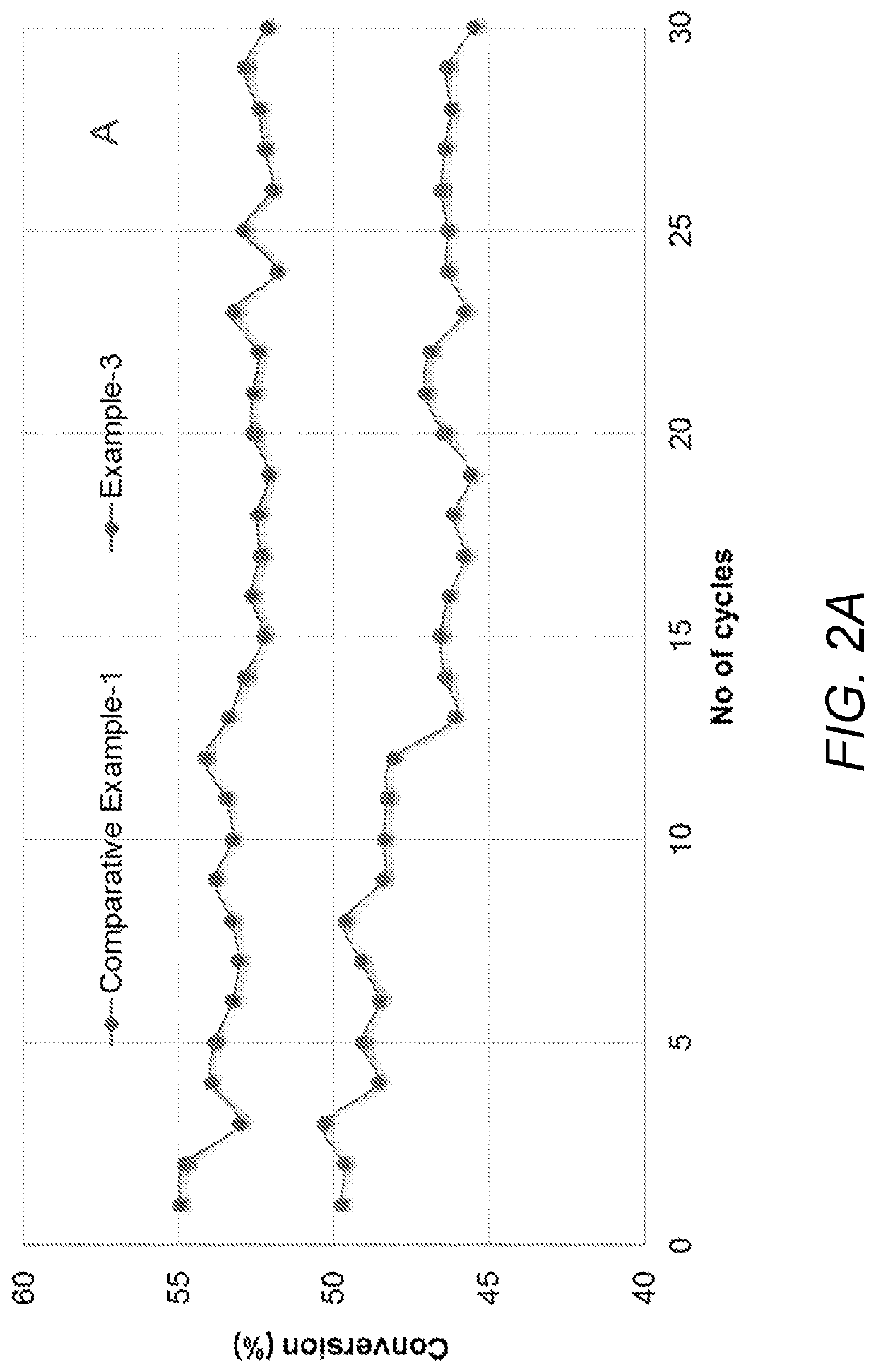Vanadium oxide supported catalyst for alkane dehydrogenation
- Summary
- Abstract
- Description
- Claims
- Application Information
AI Technical Summary
Benefits of technology
Problems solved by technology
Method used
Image
Examples
example 3
Synthesis of Vanadium Oxide / K2O Supported Catalyst of the Present Invention
[0048]Transition alumina support in the form of spheres (˜2.5 mm diameter) procured from Sasol with surface area of 137 m2 / g was used for catalyst preparation. The alumina support (about 100 g) was heat treated in an oven at 120° C. for 16 hours in the presence of air. The dried alumina support, after cooling to room temperature, was used for catalyst preparation by incipient wetness impregnation method. The catalyst was prepared by incipient wetness impregnation of the support with an aqueous solution of vanadyl oxalate. The required quantity of vanadyl oxalate (3.97 g) and potassium nitrate (0.39 g) was dissolved in water and used for incipient wetness impregnation. The impregnation was carried out by contacting the impregnation solution (12.6 mL) with alumina support (27.93 g) at room temperature. The impregnated alumina support was then kept at room temperature for 12 hours and then dried at 120° C. for 1...
example 4
Synthesis of Vanadium Oxide / K2O Supported Catalyst of the Present Invention
[0049]Transition alumina in the form of spheres (+1.8 diameter) procured from Sasol with surface area of 207 m2 / g was used for catalyst preparation. The alumina support (about 100 g) was heat treated in an oven at 120° C. for 16 hours in the presence of air. The dried alumina support, after cooling to room temperature, was used for catalyst preparation by incipient wetness impregnation method. The catalyst was prepared by incipient wetness impregnation of the support with an aqueous solution of vanadyl oxalate. The required quantity of vanadyl oxalate (7.56 g) and the required quantity of potassium nitrate (0.39 g) was dissolved in water (22.3 mL) and used for incipient wetness impregnation. The impregnation was carried out by contacting the impregnation solution with alumina support (26.2 g) at room temperature. The impregnated alumina support was then kept at room temperature for 12 hours and then dried at ...
example 5
Catalyst Characterization
[0050]The surface areas (BET) of the catalysts were determined using a Micromeritics Tristar Surface Area and Porosity Analyzer (Micromeritics Instrument Corp., USA). Prior to measurements, the sample (˜200 mg) was evacuated for 2 hrs at 300° C. to remove physically adsorbed water and N2 physisorption was carried out at −196° C. The surface area results are given in Table 1 (surface area for Comparative Example 1 and inventive Example 3) and in Table 2 (surface area for Comparative Example 2 and inventive Example 4). From the data, it was determined that catalysts prepared using vanadyl oxalate as the vanadium oxide precursor had a higher surface area as compared to catalysts prepared using ammonium metavanadate dissolved in oxalic acid as the vanadium oxide precursor.
TABLE 1VanadiumBET SAExampleFormulationprecursor(m2 / g)Transistion alumina137Comparative6.3% Vanadium oxide-AMV + OA122Example-10.6%K2O / transition aluminaExample-36.3% Vanadium oxide -VOC2O4•2H2...
PUM
| Property | Measurement | Unit |
|---|---|---|
| Temperature | aaaaa | aaaaa |
| Temperature | aaaaa | aaaaa |
| Temperature | aaaaa | aaaaa |
Abstract
Description
Claims
Application Information
 Login to View More
Login to View More - R&D
- Intellectual Property
- Life Sciences
- Materials
- Tech Scout
- Unparalleled Data Quality
- Higher Quality Content
- 60% Fewer Hallucinations
Browse by: Latest US Patents, China's latest patents, Technical Efficacy Thesaurus, Application Domain, Technology Topic, Popular Technical Reports.
© 2025 PatSnap. All rights reserved.Legal|Privacy policy|Modern Slavery Act Transparency Statement|Sitemap|About US| Contact US: help@patsnap.com



